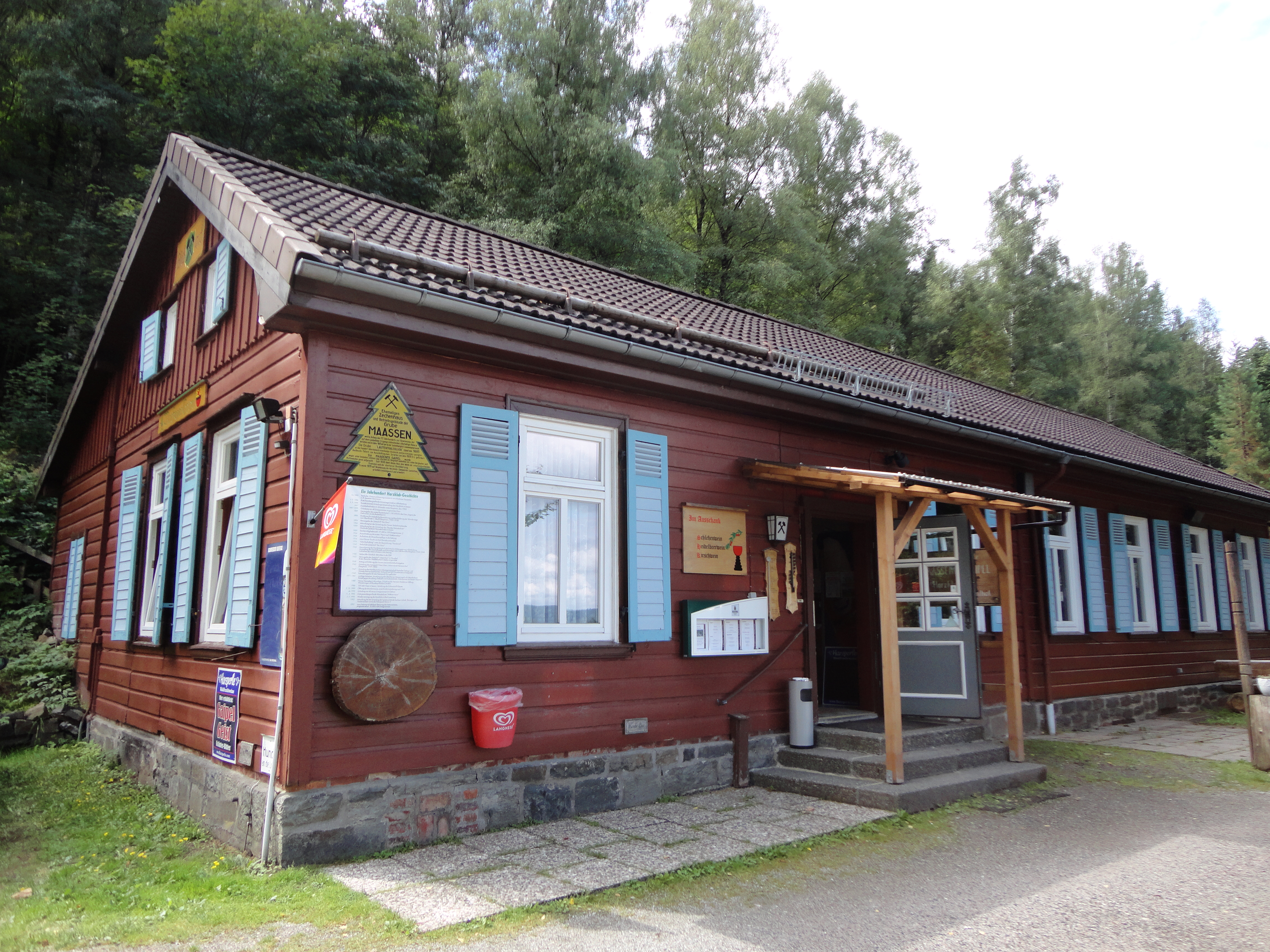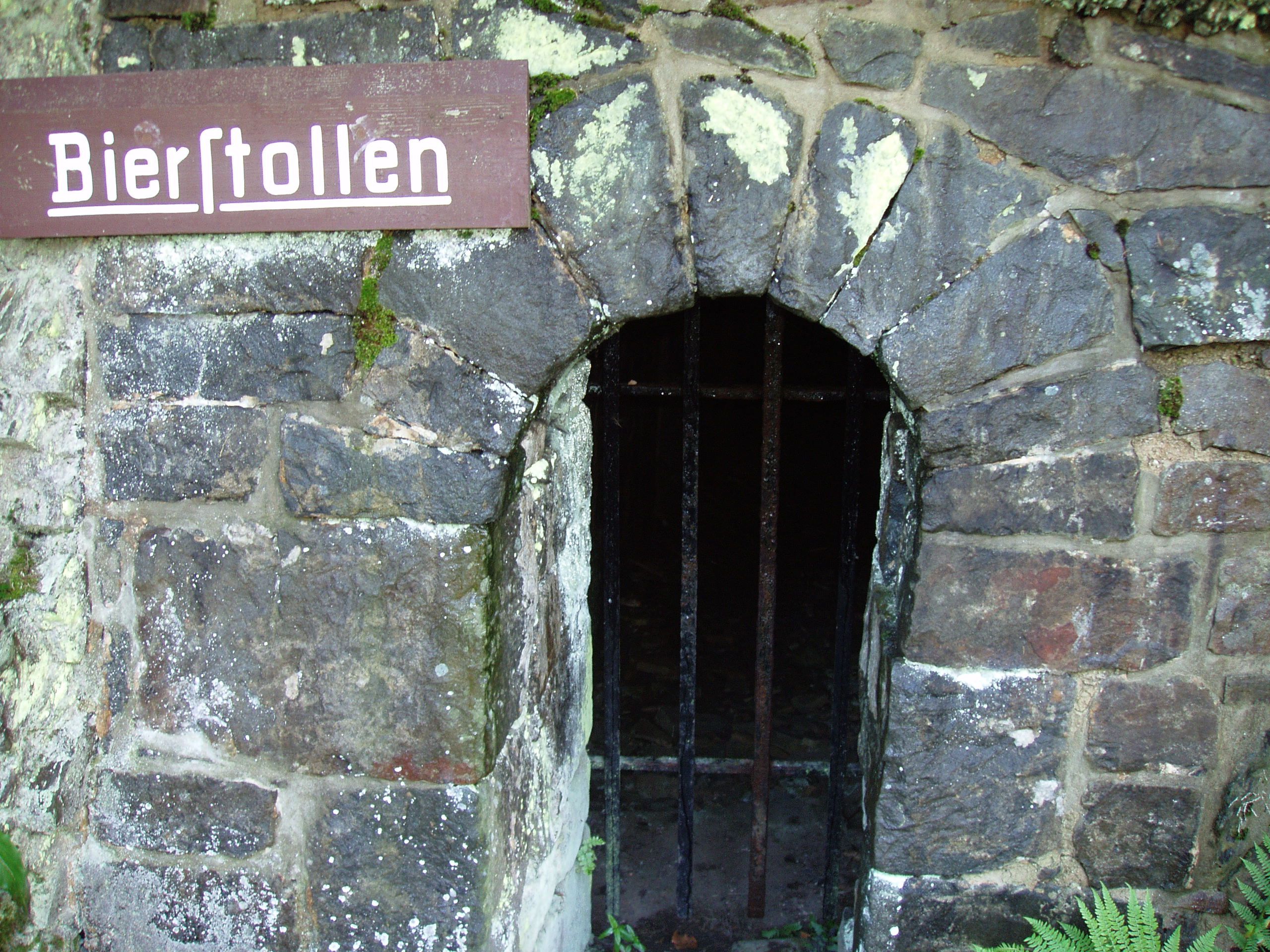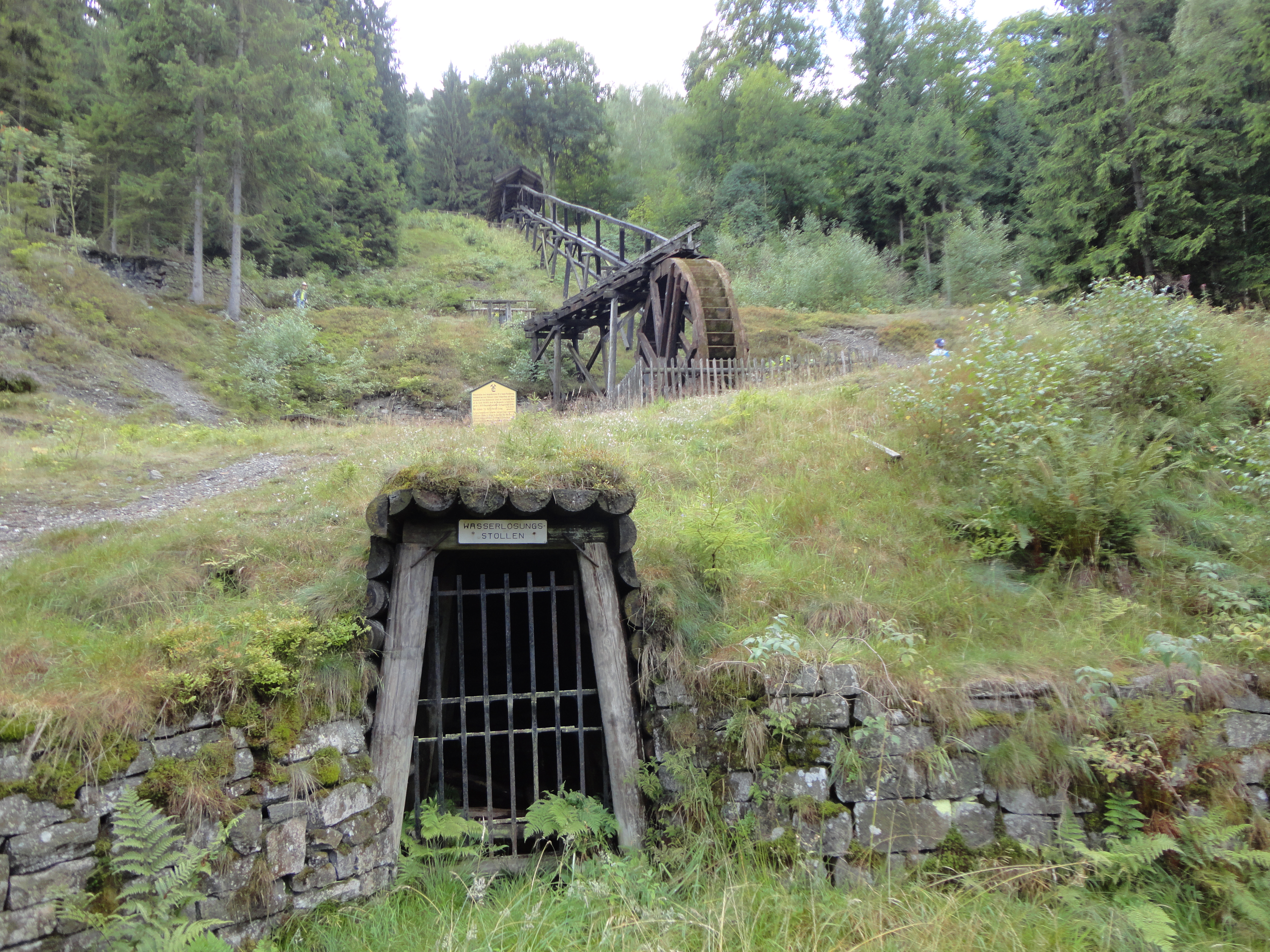Maaßener Gaipel on:
[Wikipedia]
[Google]
[Amazon]
 The Maaßener Gaipel is a pub catering for day trippers on the northeastern hillside of the Kranichsberg at a height of , situated above the mining town of
The Maaßener Gaipel is a pub catering for day trippers on the northeastern hillside of the Kranichsberg at a height of , situated above the mining town of
 The pit known as ''Grube 2., 3., 4., 5. und 6. Maß'' was first mentioned in 1622. But at some time before 1676 it was renamed the ''Grube St. Thomas'' ("St. Thomas Pit") and, in 1681, the
The pit known as ''Grube 2., 3., 4., 5. und 6. Maß'' was first mentioned in 1622. But at some time before 1676 it was renamed the ''Grube St. Thomas'' ("St. Thomas Pit") and, in 1681, the
 Because area around the mine was already being visited by walkers, in the 1860s a small garden with seating was laid out on the spoil heap. The miners operating the shaft provided visitors with hot water for brewing their coffee. When, in 1920, the mining facilities disappeared, their loss threatened this popular destination. As a result, the then chairman of the local branch of the Harz Club, master forester, ''Quickert'', and mining administrator (''Bergrat''), ''Barry'', had the idea of building a pub on the site of the Maaßener Gaipel. With donated construction wood and volunteers, a small forest inn was built from 1924 to 1925, which was managed by the Harz Club. In order to avoid the threat of closure due to its poor state of repair, from 1976 to 1978 the guest room and kitchen were modernised and toilets added. In the 1980s, the Harz Club bought the mining land, which covered an area of 14 hectares, from Preussag AG Metall.
The inn is checkpoint number 107 in the Harzer Wandernadel hiking system.
Because area around the mine was already being visited by walkers, in the 1860s a small garden with seating was laid out on the spoil heap. The miners operating the shaft provided visitors with hot water for brewing their coffee. When, in 1920, the mining facilities disappeared, their loss threatened this popular destination. As a result, the then chairman of the local branch of the Harz Club, master forester, ''Quickert'', and mining administrator (''Bergrat''), ''Barry'', had the idea of building a pub on the site of the Maaßener Gaipel. With donated construction wood and volunteers, a small forest inn was built from 1924 to 1925, which was managed by the Harz Club. In order to avoid the threat of closure due to its poor state of repair, from 1976 to 1978 the guest room and kitchen were modernised and toilets added. In the 1980s, the Harz Club bought the mining land, which covered an area of 14 hectares, from Preussag AG Metall.
The inn is checkpoint number 107 in the Harzer Wandernadel hiking system.

 A 1918 postcard shows the original headframe building. The headframe was a simple, two-storey, wooden building with a shallow
A 1918 postcard shows the original headframe building. The headframe was a simple, two-storey, wooden building with a shallow
Internet presence of the Maaßener Gaipel at arcor.de
{{DEFAULTSORT:Maassener Gaipel Silver mines in Germany Goslar (district)
Lautenthal
The formerly free mining town ('' Bergstadt'') of Lautenthal in Germany is a state-recognised, climatic spa with around 1,570 inhabitants and has been part of the borough of Langelsheim since 1972.
Geography
Lautenthal lies in the Innerst ...
in the Harz Mountains of central Germany. The name goes back to the above-ground workings of the ''Maaßener Treibschacht'' or Maaßen Hoisting Shaft , which was located immediately east of the inn. ''Gaipel'' is a common expression in the Upper Harz for a headframe
A headframe (also known as a gallows frame, winding tower, hoist frame,Ernst, Dr.-Ing. Richard (1989). ''Wörterbuch der Industriellen Technik'' (5th ed.). Wiesbaden: Oscar Brandstetter, 1989. pit frame, shafthead frame, headgear, headstock o ...
(''Schachtgebäude'' or ''Treibehaus'') and goes back to the use of a horse whim
Whim may refer to:
* Whim, U.S. Virgin Islands, a settlement
* Whim (mining), a capstan or drum with a vertical axle used in mining
* Whim (carriage), a type of carriage
* ''Whim'', a reissue of ''Adventures of Wim'', a book by George Cockroft as ...
which in German is a ''Pferdegöpel''. Whims were used to transport men and materiel up and down mineshafts, for example using man engines, and also to operate water management equipment. ''Maaßen'' is shorthand for the name of the local pit which was the ''Grube Zweite, Dritte, Vierte, Fünfte und Sechste Maß nach der Sachsenzeche''. ''Maaß'', also variously spelt ''Maaß, Maas'' or ''Mas'', is a unit of length for a pit field (''Grubenfeld'') and in mining in the Upper Harz measured 28 ''Lachter
The ''lachter'' (also ''Berglachter'') was a common unit of length used in the mining industry in Europe, usually to measure depth, tunnel driving and the size of mining fields; it was also used for contract work. In most German-speaking mining f ...
'' or 53.8 metres.
The pub was built in 1924 on the initiative of the Harz Club on the terrain of the old mine shaft. But decades before the area had already become a popular destination with walkers due to its views of the mining town and the valley of the Laute.
History
Mining
 The pit known as ''Grube 2., 3., 4., 5. und 6. Maß'' was first mentioned in 1622. But at some time before 1676 it was renamed the ''Grube St. Thomas'' ("St. Thomas Pit") and, in 1681, the
The pit known as ''Grube 2., 3., 4., 5. und 6. Maß'' was first mentioned in 1622. But at some time before 1676 it was renamed the ''Grube St. Thomas'' ("St. Thomas Pit") and, in 1681, the mine
Mine, mines, miners or mining may refer to:
Extraction or digging
* Miner, a person engaged in mining or digging
*Mining, extraction of mineral resources from the ground through a mine
Grammar
*Mine, a first-person English possessive pronoun
...
became part of the ''Lautenthals Glück'' Pit.
From 1720 the Maaßen Hoisting Shaft (''Maaßener Treibschacht'') and Maaßen Water Shaft (''Maaßener Kunstschacht'') of the ''Lautenthals Glück'' Pit were used to hoist ore and surplus water to the surface. At that time, both shafts were so-called winze
A winze is a minor connection between different levels in a mine. When worked upwards from a lower level it is usually called a raise; when sunk downward from a higher level it may be called a sump. The top of a winze is located underground and it ...
s and did not open at the surface. From 1718, the hoisting shaft had a winding engine. From 1842 to 1844 the hoisting shaft was driven to the surface. In the subsequent period, the headframe
A headframe (also known as a gallows frame, winding tower, hoist frame,Ernst, Dr.-Ing. Richard (1989). ''Wörterbuch der Industriellen Technik'' (5th ed.). Wiesbaden: Oscar Brandstetter, 1989. pit frame, shafthead frame, headgear, headstock o ...
and other above-ground facilities were added. The reversible water wheel lay 29 metres down the shaft and around 70 metres to the north. It was powered by water from the ''Oberer Richtschachter Graben''. The old water wheel of the blind hosting shaft was another 40 metres deeper in an underground wheel room. In the Maaßen Water Shaft there was a double man engine for enabling miner
A miner is a person who extracts ore, coal, chalk, clay, or other minerals from the earth through mining. There are two senses in which the term is used. In its narrowest sense, a miner is someone who works at the rock face; cutting, blasting, ...
s to journey to and from the ''Lautenthals Glück'' Pit. These and the pumping need for water management were driven by four underground water wheels, which received their water through the Maaßen Watercourse (''Maaßener Wasserlauf'') which is still visible today.
With the sinking of a new central hoisting shaft in the years 1905 to 1909 the old Maaßen shafts lost their importance. In 1908 the hoisting shaft was filled in, and its equipment dismantled by 1920. The water shaft continued to act as a ventilation shaft until the mine was closed in 1930.
Pub
 Because area around the mine was already being visited by walkers, in the 1860s a small garden with seating was laid out on the spoil heap. The miners operating the shaft provided visitors with hot water for brewing their coffee. When, in 1920, the mining facilities disappeared, their loss threatened this popular destination. As a result, the then chairman of the local branch of the Harz Club, master forester, ''Quickert'', and mining administrator (''Bergrat''), ''Barry'', had the idea of building a pub on the site of the Maaßener Gaipel. With donated construction wood and volunteers, a small forest inn was built from 1924 to 1925, which was managed by the Harz Club. In order to avoid the threat of closure due to its poor state of repair, from 1976 to 1978 the guest room and kitchen were modernised and toilets added. In the 1980s, the Harz Club bought the mining land, which covered an area of 14 hectares, from Preussag AG Metall.
The inn is checkpoint number 107 in the Harzer Wandernadel hiking system.
Because area around the mine was already being visited by walkers, in the 1860s a small garden with seating was laid out on the spoil heap. The miners operating the shaft provided visitors with hot water for brewing their coffee. When, in 1920, the mining facilities disappeared, their loss threatened this popular destination. As a result, the then chairman of the local branch of the Harz Club, master forester, ''Quickert'', and mining administrator (''Bergrat''), ''Barry'', had the idea of building a pub on the site of the Maaßener Gaipel. With donated construction wood and volunteers, a small forest inn was built from 1924 to 1925, which was managed by the Harz Club. In order to avoid the threat of closure due to its poor state of repair, from 1976 to 1978 the guest room and kitchen were modernised and toilets added. In the 1980s, the Harz Club bought the mining land, which covered an area of 14 hectares, from Preussag AG Metall.
The inn is checkpoint number 107 in the Harzer Wandernadel hiking system.
Original appearance of the mine and its traces today
 A 1918 postcard shows the original headframe building. The headframe was a simple, two-storey, wooden building with a shallow
A 1918 postcard shows the original headframe building. The headframe was a simple, two-storey, wooden building with a shallow gable roof
A gable roof is a roof consisting of two sections whose upper horizontal edges meet to form its ridge. The most common roof shape in cold or temperate climates, it is constructed of rafters, roof trusses or purlins. The pitch of a gable roof ca ...
. From the roof projected a low, steel hoisting frame with a timber-framed cover above the sheaves, which redirected the hoisting cable from the reversible water wheel into the sloping shaft. In the face of the gable wall were openings for feeding the flatrods of the water wheel which ran down the slope. The mine railway emerged from the gateway at the side of the building.
On the slope behind the headframe was the portal to an adit, which was later used by the pub as a drinks cellar under the name ''Bierstollen'' ("beer gallery").
East of the present inn building the Mining and History Society of the Mining Town of Lautenthal (''Bergwerks- und Geschichtsverein Bergstadt Lautenthal von 1976 e.V.'') built a working model of mining equipment between 1992 and 1998 in order to show the original function of the area. The water wheel at a scale of 1:2 with a six-metre diameter is not far from the spot where the reversible water wheel of the Maaßen Hoisting Shaft used to turn.
Next to the ''Bierstollen'' stands a model of a wooden pit support system, which is part of the Lautenthal Mining Education Path (''Lautenthaler Bergbaulehrpfad'').
In the area around the forest inn are several display boards on mining history including a Dennert Fir Tree
The Dennert Fir Tree (german: Dennert-Tanne also known as the , or ) is a signboard that is used throughout the Harz mountains in Germany to provide information about mining and other points of interest in the area. The signboards mark locations, ...
.
References
Literature
* * *External links
Internet presence of the Maaßener Gaipel at arcor.de
{{DEFAULTSORT:Maassener Gaipel Silver mines in Germany Goslar (district)